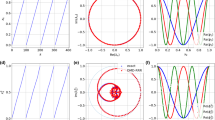Abstract
Starting from a microscopic system–environment model, we construct a quantum dynamical semigroup for the reduced evolution of the open system. The difference between the true system dynamics and its approximation by the semigroup has the following two properties: It is (linearly) small in the system–environment coupling constant for all times, and it vanishes exponentially quickly in the large time limit. Our approach is based on the quantum dynamical resonance theory.
Similar content being viewed by others
Change history
24 April 2019
Correction. The bound (2.23) in Theorem 2.1.
24 April 2019
Correction. The bound (2.23) in Theorem 2.1.
Notes
We recall that a map on bounded operators on a Hilbert space, \(V:{\mathcal B}({\mathcal H})\rightarrow {\mathcal B}({\mathcal H})\), is called completely positive if \(V\otimes {\mathbf 1}:{\mathcal B}({\mathcal H}\otimes {\mathbb C}^n)\rightarrow {\mathcal B}({\mathcal H}\otimes {\mathbb C}^n)\) is positive (maps positive operators into positive ones) for all \(n\in \mathbb N\).
If the initial state is of product form \(\omega _\mathrm{S}\otimes \omega _{\mathrm{R},\beta }\), then the term \( C |\lambda |\mathrm{e}^{-\theta _0 t}\) in (2.13) can be replaced by \( C \lambda ^2\mathrm{e}^{-\theta _0 t}\), see Theorem 3.1 of [20], Resonance theory of decoherence and thermalization.
\(\Omega _{\mathrm{S},\beta }\) is cyclic, meaning that \(({\mathcal B}({\mathcal H}_\mathrm{S})\otimes {\mathbf 1}_\mathrm{S})\Omega _{\mathrm{S},\beta }={\mathcal H}_\mathrm{S}\otimes {\mathcal H}_\mathrm{S}\) and \(\Omega _{\mathrm{S},\beta }\) is separating, meaning that if \((X\otimes {\mathbf 1}_\mathrm{S})\Omega _{\mathrm{S},\beta }=0\) then \(X=0\). Due to the cyclic and separating property, (2.14) defines the map \(\delta ^t_\lambda \) uniquely, and it shows that \(t\mapsto \delta ^t_\lambda \) is a group.
One may also follow an extended Mourre theory approach, recently developed in [15]. This method is more powerful in that it requires less restrictive assumptions, but it is technically somewhat more demanding.
Use the estimate \(|\mathrm{e}^{-\lambda ^2 t\mathrm{Im }a_{e,j}} - \mathrm{e}^{-\lambda ^2 t\mathrm{Im }\widetilde{\lambda }_{e,j}}| = \mathrm{e}^{-\lambda ^2 t\mathrm{Im }a_{e,j}}|1-\mathrm{e}^{\lambda ^2 t\mathrm{Im }(a_{e,j}-\widetilde{\lambda }_{\widetilde{e},j})}| \leqslant \mathrm{const.} |\lambda |^3 t \mathrm{e}^{-\lambda ^2(1+O(\lambda ))\gamma t}\).
References
Alicki, R., Lendi, K.: Quantum dynamical semigroups and applications, Lecture notes on physics, vol. 717. Springer Verlag, New York (2007)
Araki, H., Woods, E.J.: Representation of the canonical commutation relations describing a nonrelativistic infinite free bose gas. J. Math. Phys. 4, 637–662 (1963)
Benatti, F., Floreanini, R.: Open quantum dynamics: complete positivity and entanglement. Int. J. Mod. Phys. B 19, 3063 (2005)
Bach, V., Fröhlich, J., Sigal, I.M.: Return to equilibrium. J. Math. Phys. 41(6), 3985–4060 (2000)
Breuer, H.-P., Petruccione, F.: The theory of open quantum systems. Oxford University Press, Oxford (2006)
Bratteli, O., Robinson, D.W.: Operator algebras and quantum statistical mechanics, vol. 1 and 2. Springer Verlag, New York (1979)
Davies, E.B.: Markovian master equations. Commun. Math. Phys. 39, 91–110 (1974)
Davies, E.B.: Markovian master equations, II. Math. Annalen 219, 147–158 (1976)
Derezinski, J., Jaksic, V., Pillet, C.-A.: Perturbation theory of \(W^*\)-dynamics, Liouvilleans and KMS-states. Rev. Math. Phys. 15(5), 447–489 (2003)
Dümke, R., Spohn, H.: The proper form of the generator in the weak coupling limit. Z. Phys. B 34, 419–422 (1979)
Fröhlich, J., Merkli, M.: Another return of “return to equilibrium”. Commun. Math. Phys. 251(2), 235–262 (2004)
Gardiner, C.W., Zoller, P.: Quantum noise. Springer series in synergetics, 3rd edn. Springer, Berlin (2004)
Jaksic, V., Pillet, C.-A.: From resonances to master equations. Ann. Inst. H. Poincaré Phys. Théor. 67(4), 425–445 (1997)
Jaksic, V., Pillet, C.-A.: On a model for quantum friction. II. Fermi’s golden rule and dynamics at positive temperature. Commun. Math. Phys. 176(3), 619–644 (1996)
Könenberg, M., Merkli, M.: On the irreversible dynamics emerging from quantum resonances. J. Math. Phys. 57, 033302 (2016)
Merkli, M.: Entanglement evolution via quantum resonances. J. Math. Phys. 52(9), 092201 (2011)
Merkli, M., Berman, G.P., Sayre, R.: Electron transfer reactions: generalized Spin–Boson approach. J. Math. Chem. 51(3), 890–913 (2013)
Merkli, M., Berman, G.P., Song, H.: Multiscale dynamics of open three-level quantum systems with two quasi-degenerate levels. J. Phys. A Math. Theor. 48, 275304 (2015)
Merkli, M., Berman, G.P., Sayre, R.T., Gnanakaran, S., Könenberg, M., Nesterov, A.I., Song, H.: Dynamics of a chlorophyll dimer in collective and local thermal environments. J. Math. Chem. 54(4), 866–917 (2016)
Merkli, M., Sigal, I.M., Berman, G.P.: Resonance theory of decoherence and thermalization. Ann. Phys. 323, 373–412 (2008)
Merkli, M., Sigal, I.M., Berman, G.P.: Decoherence and thermalization. Phys. Rev. Lett. 98(13), 130401–130405 (2007)
Merkli, M., Sigal, I.M., Berman, G.P.: Dynamics of collective decoherence and thermalization. Ann. Phys. 323(12), 3091–3112 (2008)
Mukamel, S.: Principles of nonlinear spectroscopy. Oxford series in optical and imaging sciences. Oxford University Press, Oxford (1995)
Author information
Authors and Affiliations
Corresponding author
Rights and permissions
About this article
Cite this article
Könenberg, M., Merkli, M. Completely positive dynamical semigroups and quantum resonance theory. Lett Math Phys 107, 1215–1233 (2017). https://doi.org/10.1007/s11005-017-0937-z
Received:
Revised:
Accepted:
Published:
Issue Date:
DOI: https://doi.org/10.1007/s11005-017-0937-z




